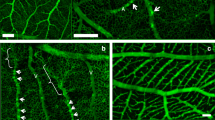Summary
The fetal microvascular architecture of the feline near-term placenta was investigated using scanning electron micrographs of partially fractured corrosion casts from plastic-filled vessels. The findings were compared with those on corresponding semithin histological sections.
The branches of both umbilical arteries and veins roughly follow a course parallel to the zonary girdle on the allantochorionic side of the feline placenta in an acute-angled pattern of ramifications. They join the double-layered capilary networks in the chorionic lamellae of the labyrinth, which generally exhibit a chorio-uterine orientation and are partially twirled. On the allantochorionic side of the labyrinth, these fetal capillary networks are “suspended” on the maternal stem-artery-system of the placenta; on the uterine side, they have peduncular or tuft-like endings of capillary loops and are flattened by the uterine septa, which at this level converge into the maternal veins. The chorionic capillary lamellae have a variable breadth and length and therefore need shorter or longer arterioles and venules from the allantochorionic side to become irrigated at any level of the labyrinth.
As a result, the feline placenta is characterized by a generally one-way crosscurrent type of materno-fetal blood flow.
Similar content being viewed by others
References
Faber JJ (1977) Steady-state methods for the study of placental exchange. Fed Proc 36:2640–2646
Faber JJ, Hart FM (1966) The rabbit placenta as an organ of diffusional exchange. Comparison with other species by dimensional analysis. Circ Res 19:816–833
Habashi S, Burton GJ, Steven DH (1983) Morphological study of the fetal vasculature of the human term placenta: Scanning electron microscopy of corrosion casts. Placenta 4:41–56
Kaufmann P, Davidoff M (1977) The guinea-pig placenta. Adv Anat Embryol Cell Biol 53/2. Springer, Berlin Heidelberg New York
Kehrer A (1973) Zur Entwicklung und Ausbildung des Chorions der Plazenta zonaria bei Katze, Hund und Fuchs. Z Anat Entwickl Gesch 143:25–42
Kohler T, Leiser R (1983) Blood vessels of the bovine chorioidea. Acta Anat 116:55–61
Leiser R (1980) Funktionelle Morphologie der Implantation und der frühen Plazentation bei der Hauskatze; Licht- und elektronenmikroskopische Untersuchungen mit histocytochemischer Ergänzung. Habil-Schrift Bern: 1–162
Leiser R (1984) Fetal vasculature of the human placenta: Scanning electronmicroscopy of microvascular casts. Contr Gyn and Obst [in press]
Leiser R, Enders AC (1980) Light and electron-microscopic study of the near-term paraplacenta of the domestic cat. I. Polar zone and paraplacental junctional areas. Acta Anat 106:293–311
Leiser R, Kohler T (1983) The blood vessels of the cat girdle placenta. Observations on corrosion casts, scanning electron microscopical and histological studies. I. Maternal vasculature. Anat Embryol 167:85–93
Leiser R, Kaufmann P, Luckhardt M (1984) Materno-fetal vessel interrelationship in different types of placenta [in preparation]
MacDonald AA (1981) The vascular anatomy of the pig placenta: A scanning electron microscope study. Acta Morphol Neerl Scand 19:171–172
Malassiné A (1974) Evolution ultrastructurale du labyrinthe de placenta de chatte. Anat Embryol 146:1–20
Martin CB, Jr (1981) Models of placental blood flow. In: Wallenburg HCS, van Kreel BK, van Dijk JP (eds) Transfer across the primate and non-primate placenta, chapt 5. Saunders & Co, London Philadelphia Toronto
Moll W (1972) Gas exchange in concurrent, countercurrent and crosscurrent flow systems. The concept of the fetoplacental unit. In: Longo LD, Bartels H (eds) Respiratory gas exchange and blood flow in the placenta. 281–294 US Department of Health, Education and Welfare DHEW Pub No (NIH) 73-361
Moll W (1981) Physiologie des fetalen plazentaren Kreislaufs. In: Becker V, Schiebler TH, Kubli F (eds) Die Plazenta des Menschen. Thieme, Stuttgart New York, pp 195–198
Risco JM, Nopanitaya W (1980) Ocular microcirculation. Scanning electron microscopic study. Invest Ophthalmol Vis Sci 19:5–12
Schultze O (1897) Grundriss der Entwicklungsgeschichte des Menschen und der Säugetiere, 1. Aufl. Engelmann, Leipzig
Spörri H (1976) Blutkreislauf. In: Scheunert A, Trautmann A (eds) Lehrbuch der Veterinär-Physiologie, chapt 8. Parey, Berlin Hamburg
Thiriot M, Panigel M (1978) Microcirculation. — La microvascularisation des villosités placentaires humaines. CR Acad Sci [Paris] Ser D 287:709–712
Author information
Authors and Affiliations
Additional information
Supported by the “Stiftung zur Förderung der wissenschaftlichen Forschung an der Universität Bern”
Rights and permissions
About this article
Cite this article
Leiser, R., Kohler, T. The blood vessels of the cat girdle placenta. Observations on corosion casts, scanning electron microscopical and histological studies. Anat Embryol 170, 209–216 (1984). https://doi.org/10.1007/BF00319006
Accepted:
Issue Date:
DOI: https://doi.org/10.1007/BF00319006




